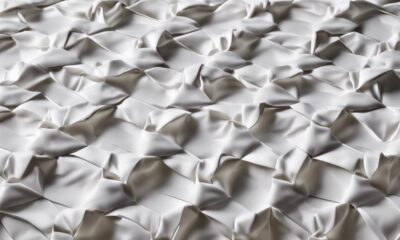Home Decor & Design
Batik Hacks: Transform Your Space With These Timeless Patterns
Awaken your home decor with stunning batik patterns and discover creative ways to seamlessly elevate your space—let the transformation begin!
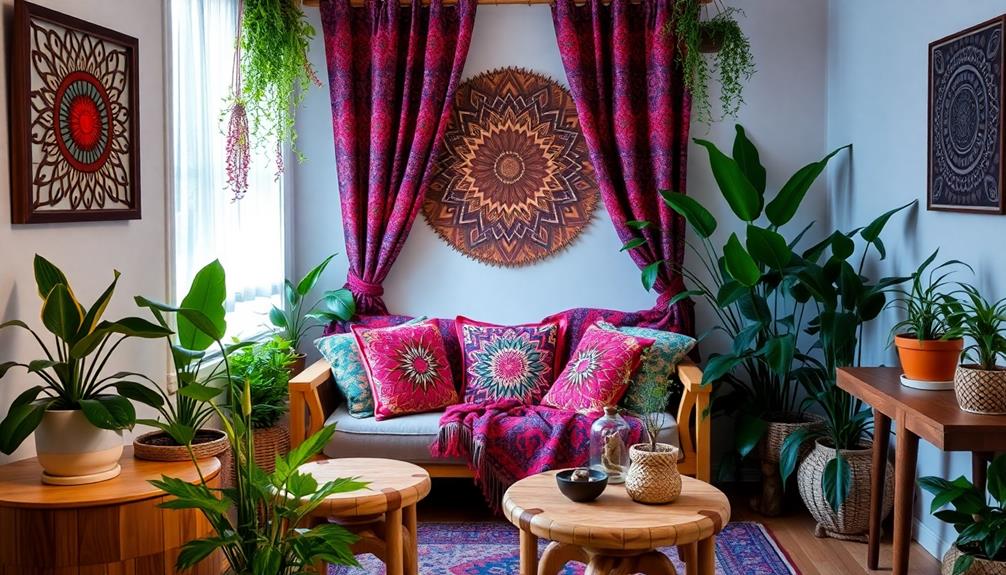
Batik can instantly elevate your home decor with its rich colors and intricate designs. You can frame various batik fabrics as stunning wall art or create a gallery wall for visual interest. Revamp your cushions using vibrant batik covers to infuse your living space with cultural elegance. Don't forget to layer batik table runners and placemats for a cohesive design theme at your dining table. Even unique accessories like coasters made from batik can add character to your home. There's plenty more inspiration to explore that can help you transform your space beautifully. For a complete batik design theme, consider incorporating batik prints into your curtains or drapes for a cohesive look. You can also experiment with mixing and matching different batik patterns and colors to add depth and dimension to your decor. Don’t be afraid to play with scale and placement when using batik fabrics for upholstery or even as a statement rug in your home. These batik design tips can help you create a truly distinctive and inviting living space that reflects your personal style and appreciation for cultural artistry.
Key Takeaways
- Frame and display vibrant batik fabrics to create stunning wall art that adds cultural elegance to your space.
- Revamp your cushions with durable cotton batik covers for a pop of color and traditional flair.
- Use batik cloth as eye-catching table runners or placemats to enhance dining experiences with cultural significance.
- Create functional decor like coasters and trays using batik fabric to blend style with practicality in your home.
- Experiment with arrangements of batik pieces to reflect your personal style while celebrating Indonesian heritage.
Understanding Batik Patterns
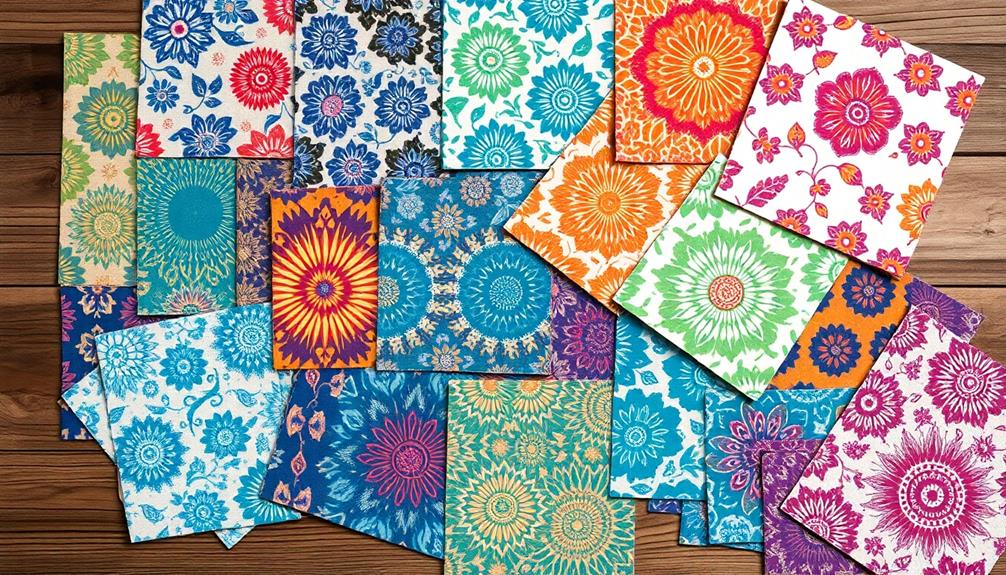
When you explore batik patterns, you'll discover a rich tapestry of intricate designs created through a wax-resist dyeing technique. This method not only allows for vibrant colors but also showcases detailed motifs that reflect cultural significance.
In addition to batik, the appreciation for Indonesian decor masks highlights the country's artistic diversity. Let's investigate the common themes of batik, which often include natural elements like foliage and geometric patterns. These geometric shapes, alongside organic forms, represent the rich biodiversity and traditions of Indonesia.
Skilled artisans craft these unique patterns, and many designs have been passed down through generations, preserving cultural heritage. When you appreciate the craftsmanship behind each piece, you start to understand the stories woven into the fabric.
For instance, specific motifs can symbolize various aspects of life, love, or nature, enhancing your connection to the art. Batik fabric often features duplicated prints, providing a cohesive look for various applications, whether in home decor or fashion.
Understanding these patterns enables you to select the right designs that resonate with you, allowing your space to reflect personal values while celebrating an age-old art form. Embrace the beauty and meaning behind batik; it's more than just fabric—it's a story.
Creative Wall Art Ideas

Batik fabric can transform your walls into vibrant showcases of art and culture. By incorporating batik into your home decor, you can create eye-catching focal points that reflect your personal style and appreciation for intricate designs.
These stunning pieces can easily complement other elements of Indonesian interior design, such as Indonesian Decorative Pillows, to enhance the overall aesthetic of your space. Here are some creative wall art ideas to get you started:
- Frame Batik Pieces: Choose various batik fabrics and frame them as stunning wall art, showcasing their intricate patterns and vibrant colors.
- Create a Gallery Wall: Combine different batik patterns within a gallery wall layout, using eclectic frame styles to add visual interest and depth.
- Fabric on Canvas: Use adhesive or sewing techniques to attach batik fabric to canvas, creating polished wall hangings that can be customized to fit your decor.
- Statement Art: Consider larger batik pieces as statement art to anchor a room, providing a striking contrast against neutral walls while enhancing the overall aesthetic.
These ideas not only beautify your space but also infuse it with a unique cultural flair. Experiment with different arrangements and pieces to find what resonates with you!
Revamping Cushions With Batik
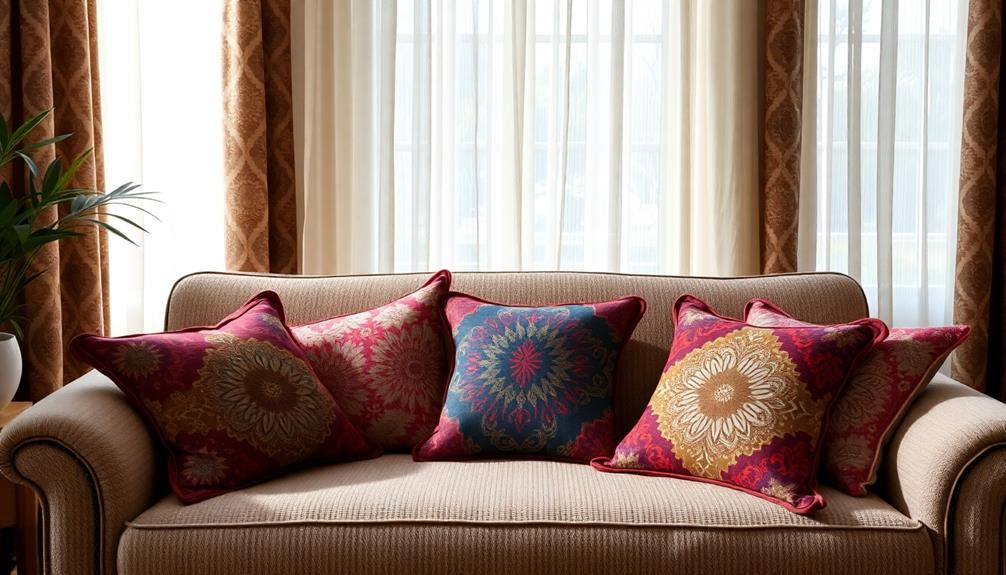
Transforming your cushions with batik fabric covers is a fantastic way to infuse your living space with vibrant color and cultural elegance. This easy sewing project allows you to turn plain cushions into stunning decor that enhances your overall aesthetic.
Consider pairing your batik cushions with traditional Indonesian decor masks to create a cohesive and culturally rich atmosphere in your home. The intricate patterns and rich hues not only add visual interest but also provide comfort and a touch of sophistication, making them suitable for both casual and formal settings.
When selecting your fabric, opt for versatile cotton batik. This durable material guarantees your revamped cushions can withstand everyday use while maintaining their vibrant colors and intricate designs.
Plus, incorporating batik patterns into your cushion covers is a beautiful way to celebrate Indonesian culture and craftsmanship, bringing a unique flair to your home decor. Masks symbolize spiritual beliefs that can complement your newly decorated space beautifully.
With just a little effort, you can revamp your cushions and transform your living space into a vibrant oasis filled with artistic expression.
Elegant Batik Table Decor
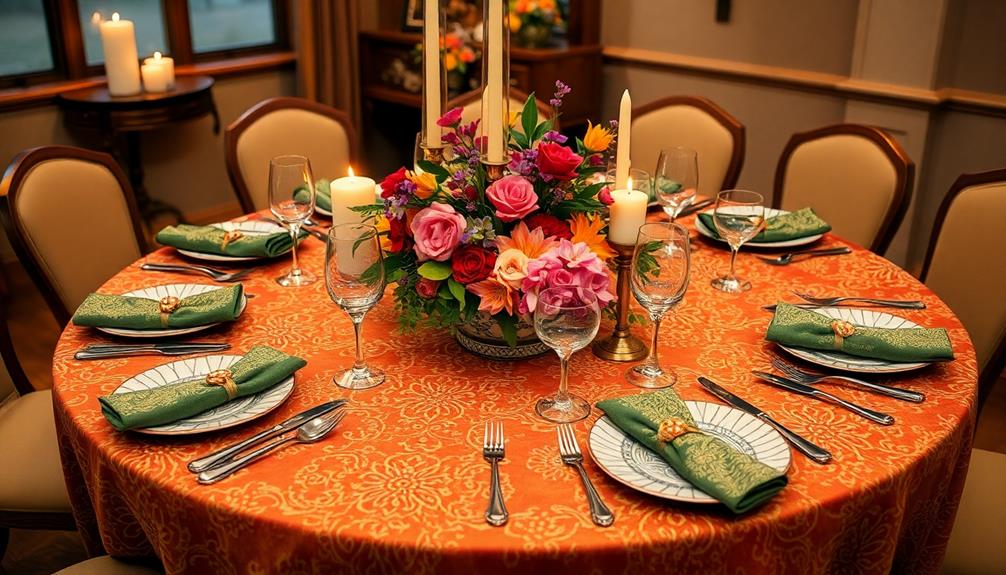
Setting a beautiful table can elevate any dining experience, and incorporating batik decor is a stunning way to achieve that. You can use batik cloth as elegant table runners or placemats to infuse cultural flair into both casual and formal occasions. The vibrant colors and intricate patterns add a touch of sophistication, making every meal feel special.
Adding unique elements like Indonesian decor masks can further enhance the cultural richness of your dining space.
To create a cohesive design theme, coordinate batik patterns with your tableware. This will enhance the overall aesthetic and showcase the unique beauty of the fabric. Plus, durable 100% cotton batik fabric can withstand spills and stains, making it a practical choice for everyday use.
Consider layering batik elements for added impact:
- Use matching placemats and napkins for a polished look.
- Incorporate a unique batik fabric as a centerpiece to draw attention.
- Choose colors that complement your existing tableware.
- Celebrate cultural heritage while impressing your guests.
With these tips, your table setting won't only look elegant but also provide an opportunity to share your appreciation for batik artistry. Transform your dining experience with these timeless patterns today!
Unique Batik Home Accessories
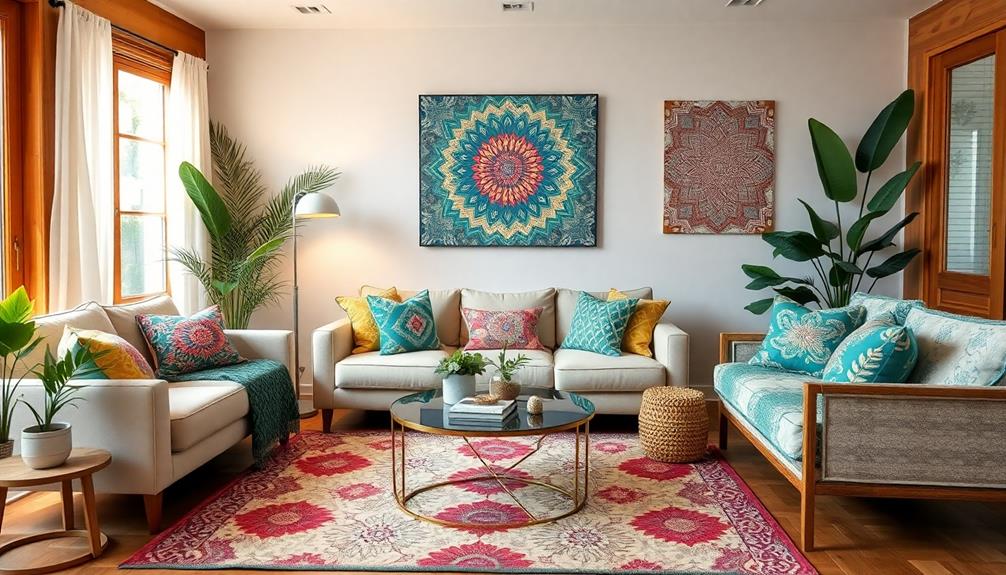
Incorporating batik into your home accessories adds a unique flair that elevates your decor beyond traditional designs. You can create functional batik-inspired pieces like coasters, trays, and storage boxes using decoupage techniques. These simple projects not only add artistic flair but also serve practical purposes in your home.
Additionally, the use of natural materials in your designs can harmonize with the calming atmosphere typical of Balinese interior design. Transform your plain cushions into vibrant statement pieces by incorporating batik fabric into cushion covers. This change enhances the overall aesthetic of any room, infusing it with color and texture.
For dining settings, consider using batik cloth as table runners or placemats, adding a touch of elegance perfect for both special occasions and everyday meals.
Don't forget about wall art! Frame pieces of batik fabric to create visual interest and cultural expression in your living space. Mix different patterns to create a dynamic gallery wall that draws the eye.
Lastly, explore sustainable crafting practices by upcycling materials and incorporating batik designs into your accessories. This not only showcases your creativity but also emphasizes environmental responsibility, making your home both stylish and eco-friendly.
With these ideas, you'll transform your space into a haven of batik beauty.
Frequently Asked Questions
What Materials Are Best for Batik Projects at Home?
For your batik projects at home, you'll need cotton or silk fabric, wax, a tjanting tool, and vibrant dyes. These materials help you create stunning designs that showcase your creativity and personal style.
How Do I Care for Batik Fabrics?
Caring for batik fabrics is like nurturing a delicate flower. You should hand wash them in cold water, avoid harsh detergents, and never wring them out. Air dry them to maintain their vibrant colors and patterns.
Can I Use Batik Patterns in Outdoor Decor?
You can absolutely use batik patterns in outdoor decor! They add a unique flair to your space. Just guarantee you choose durable, weather-resistant fabrics to maintain their vibrant colors and intricate designs over time.
Where Can I Buy Authentic Batik Materials?
Finding authentic batik materials is like searching for hidden treasures. You can explore local artisan shops, online marketplaces, or dedicated craft stores. Each source offers unique patterns that'll elevate your decor and inspire creativity.
Are There Eco-Friendly Batik Options Available?
Absolutely, you can find eco-friendly batik options! Look for brands that use natural dyes and sustainable fabrics. Online marketplaces and local artisans often provide these environmentally conscious choices, ensuring your batik pieces are stylish and responsible.
Conclusion
By embracing batik patterns, you're not just decorating your space; you're weaving a story of culture and creativity. The theory that colors and patterns can influence mood holds true—those vibrant designs can spark joy and inspire relaxation. So, whether you're hanging up wall art or revamping cushions, these timeless patterns can transform your home into a sanctuary of style. Immerse yourself in the world of batik, and watch your space come alive with personality and charm!
Home Decor & Design
Unlock the Hidden Power of Feng Shui to Elevate Your Interior!
Incorporate the secrets of Feng Shui to transform your space and enhance your well-being; discover how small changes can lead to significant improvements.

Revealing the hidden power of Feng Shui can greatly elevate your interior and well-being. Start by decluttering your space to enhance energy flow and create a calming atmosphere. Incorporate natural materials like wood and stone for tranquility. Use the Bagua Map to pinpoint areas needing enhancement. Balance the five elements—Wood, Fire, Earth, Metal, and Water—to guarantee harmony throughout your home. Personalize your spaces with colors and meaningful items that resonate with you. Simple adjustments can make a big difference. Keep exploring, and you'll uncover even more transformative tips to help you achieve your ideal living environment.
Key Takeaways
- Declutter regularly to enhance energy flow, improving mood and creating a more inviting space.
- Incorporate natural materials like wood and stone to promote tranquility and creativity in your interiors.
- Use the Bagua Map to target specific areas of your life for personalized enhancements in your home.
- Balance the five elements—Wood, Fire, Earth, Metal, and Water—to create harmony and positive energy throughout your space.
- Personalize your decor with meaningful artifacts and colors that reflect your aspirations and enhance emotional connections.
Understanding Feng Shui Principles
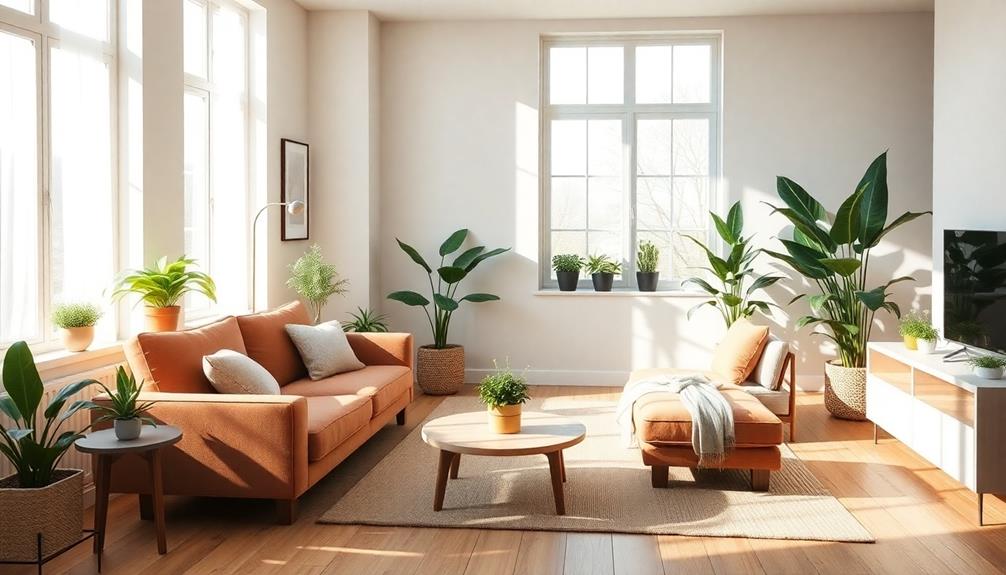
Feng Shui is all about balancing energy, or chi, in your living spaces to boost your well-being and create harmony. Understanding Feng Shui principles is fundamental for achieving a harmonious living space.
First, focus on decluttering; removing unnecessary items allows for a clear energy flow, which greatly impacts your mood and mental clarity. Additionally, incorporating natural materials like wood and stone can enhance the overall energy and tranquility of your space.
Next, utilize the Bagua Map, a critical tool that divides your space into nine areas, each representing different aspects of life, like health and relationships. By identifying which areas need improvement, you can make targeted enhancements that align with your goals.
It's also important to personalize your space according to Feng Shui principles. Incorporating elements that resonate with you'll create a nurturing environment that reflects your preferences and enhances your happiness.
The Five Elements of Feng Shui
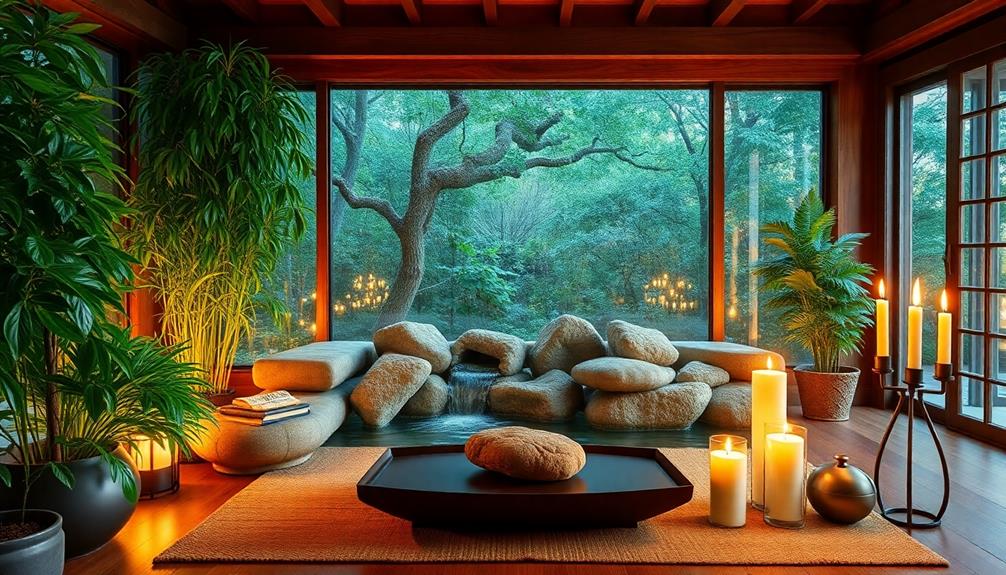
To create a harmonious space, you need to balance the Five Elements of Feng Shui: Wood, Fire, Earth, Metal, and Water.
Each element brings its own unique energy, so incorporating element-specific decor can enhance your environment's flow and liveliness.
For instance, using Indonesian Decorative Pillows can introduce vibrant colors and intricate patterns that resonate with the Wood element.
Let's explore how to effectively use these elements to boost your home's energy and overall well-being.
Balancing the Elements
Achieving a harmonious living space often hinges on balancing the five elements of Feng Shui—Wood, Fire, Earth, Metal, and Water. Each element brings its own unique energy, and it's essential to guarantee they work together seamlessly.
To create a tranquil atmosphere reminiscent of traditional Indonesian style home decor, incorporate natural materials such as wood and stone, which can promote growth and creativity.
To start, incorporate the Wood element through vibrant greens and browns found in plants or wooden furniture, which can promote growth and creativity. Next, introduce the Fire element with bold reds and oranges; these colors can ignite passion and enhance social interactions.
For stability, focus on Earth elements like warm yellows and beiges, using natural materials to ground your space. Meanwhile, Metal's whites and grays can add clarity and focus, so consider minimalist designs and geometric patterns.
Element-Specific Decor Tips
Incorporating element-specific decor tips can truly elevate your living space and enhance the energy flow within it.
Start with the Wood element; introduce plants like lucky bamboo or peace lilies, and use earthy colors like green and brown to symbolize growth and liveliness. You might also consider adding a Face Indonesian Decor Mask to celebrate cultural craftsmanship, which can further enrich the ambiance.
For the Fire element, add bold accents of red, orange, or purple, and play with various lighting sources to create a warm, inspiring atmosphere.
Next, focus on the Earth element. Use warm colors such as yellow and terracotta, and incorporate natural materials like clay and stone to ground your space and promote stability.
To reflect clarity and precision, adopt the Metal element by integrating metallic finishes and minimalist designs, complemented by geometric patterns that emphasize order.
Energy Flow Enhancement
Understanding the Five Elements of Feng Shui—Wood, Fire, Earth, Metal, and Water—can transform your living space into a sanctuary of balance and harmony. Each element carries unique energies that are crucial for enhancing energy flow throughout your home. Incorporating traditional artistry through decorative pieces like Indonesian masks can further enrich the ambiance of your space.
Start by incorporating the Wood element through plants or earthy colors to promote growth and vibrancy. Next, use the Fire element, represented by warm colors, to ignite passion and creativity in your space. Ground yourself with the Earth element by utilizing natural materials and warm tones, fostering stability.
For clarity and focus, bring in the Metal element with minimalist designs and geometric patterns. Finally, don't underestimate the power of the Water element; flowing shapes and reflective surfaces encourage adaptability and emotional health. A water feature like a fountain can be essential for positive energy flow.
To achieve ideal balance, refer to the Bagua Map, which helps you position these five elements in their corresponding areas. By thoughtfully implementing these elements, you'll enhance your home's overall energy flow, ultimately improving your well-being and life satisfaction.
Embrace Feng Shui, and watch your living space flourish!
Enhancing Energy Flow in Your Home
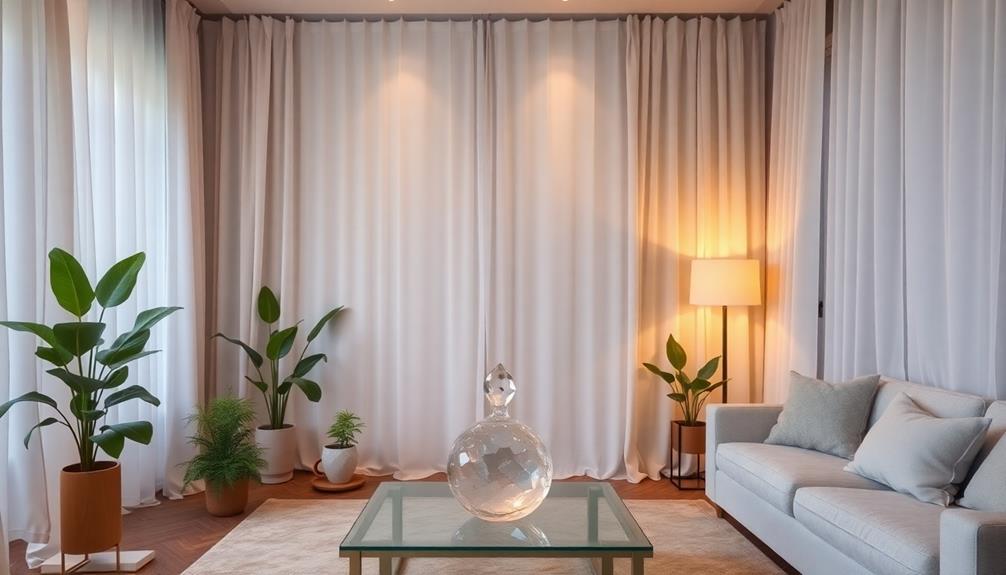
To enhance the energy flow in your home, start by decluttering your space. Clutter can block the movement of Qi, leading to stagnant energy that affects your mood negatively.
Implement effective decluttering strategies by tackling one area at a time and letting go of items that no longer serve you. Once you've cleared the space, arrange your furniture to promote accessibility and movement; this helps facilitate a smooth flow of energy, encouraging connectivity and interaction among everyone in your home.
Incorporating natural light is another key aspect of enhancing energy flow. Allow sunlight to flood your rooms, invigorating the atmosphere and uplifting your mood.
You can also use the Bagua Map to identify specific areas in your home that need focus—this way, you can make targeted adjustments to improve aspects like wealth and relationships.
Identifying and Mitigating Imbalances
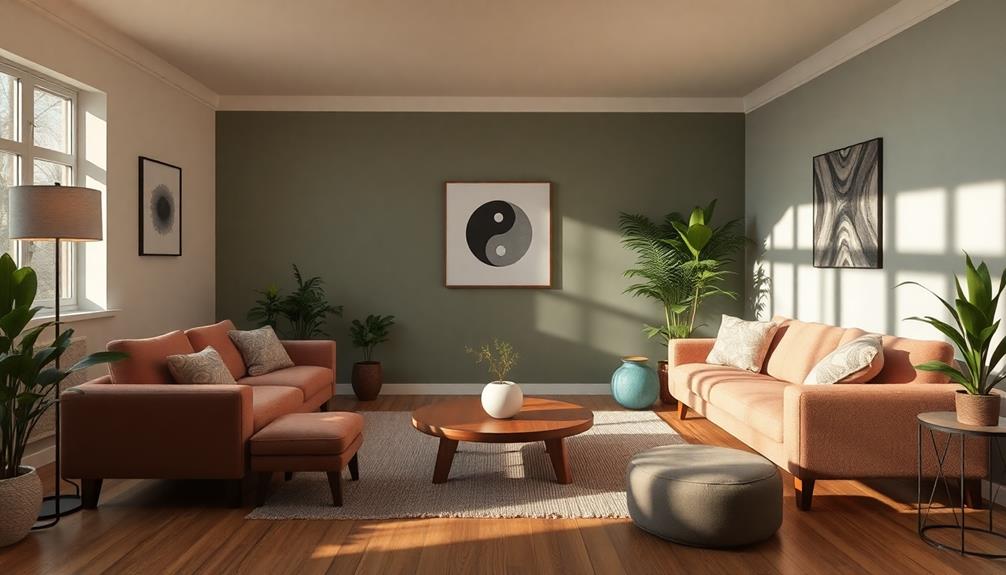
After enhancing the energy flow in your home, it's essential to identify and mitigate any imbalances that may arise.
Start by recognizing emotional and physical symptoms that might indicate an issue. For instance, if you're feeling lethargic, it could signal an excess of water or a lack of fire elements. Similarly, feelings of impulsiveness or anxiety might point to an overload of fire energy, calling for calming elements like earth tones or water features to restore balance.
Evaluate your relationships, as imbalances can also manifest here. If you're experiencing tension, a deficiency in earth elements might be at play, disrupting grounding and stability in shared spaces.
Clutter Management Strategies
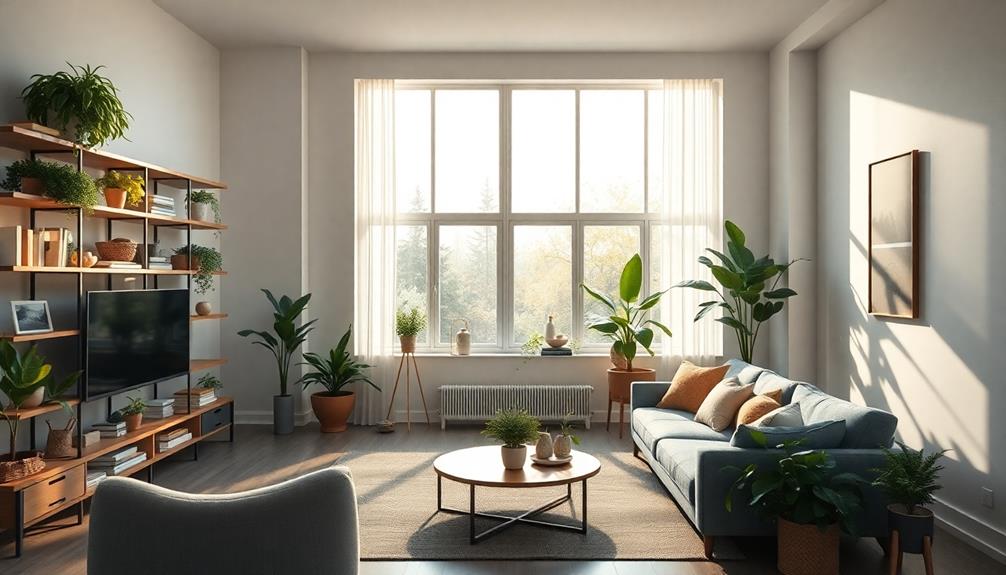
To create a harmonious environment, you need to declutter regularly and prioritize essential items.
Start by evaluating what truly adds value to your space and let go of the rest.
Organizing your spaces won't only clear away the chaos but also invite positive energy into your home.
Declutter Regularly
Regularly decluttering your space is crucial for maintaining a clear flow of Qi. Clutter can block energy pathways, leading to feelings of chaos and stagnation. To create a balanced, harmonious environment, establish a routine for decluttering by setting aside specific times each week or month. This practice guarantees your surroundings remain conducive to positive energy.
Consider implementing the "one in, one out" rule: for every new item you bring into your home, let go of an existing one. This strategy prevents accumulation and helps maintain balance. Focus on clutter-prone areas like entryways, bedrooms, and kitchens, as these spaces greatly impact your home's energy flow.
To further enhance your decluttering process, try a "joy check." Regularly evaluate your possessions by reviewing each item's emotional significance. This technique helps you prioritize what to keep, guaranteeing that your space is filled with items that genuinely uplift you.
Prioritize Essential Items
Prioritizing essential items is key to effective clutter management and creating a harmonious living space. Start by decluttering your belongings regularly. Assess everything you own and categorize items into keep, donate, and discard. This process helps you prioritize essential items that truly enhance your life while eliminating unnecessary distractions.
Focus on key areas like entryways, kitchens, and bedrooms, as they greatly impact your home's overall energy flow. A clutter-free entryway welcomes positive energy, while a tidy kitchen promotes health and nourishment.
Utilize the Bagua Map to identify specific areas in your home that may need attention. Align your decluttering efforts with personal goals, such as enhancing your wealth, health, or relationships.
Incorporate storage solutions that blend with your decor to maintain organization. By doing this, you'll create a clean and inviting atmosphere that encourages positive energy.
Create Organized Spaces
Creating organized spaces starts with a clear vision of how you want your home to feel. Decluttering is essential, as it promotes the free flow of energy (Qi) and removes obstacles that disrupt harmony. Utilize the Bagua Map to pinpoint cluttered areas that align with your personal goals, guiding your decluttering efforts effectively.
Regularly assess your possessions and let go of items that no longer serve a purpose. This practice fosters a nurturing environment, promoting calm and clarity. Focus on key clutter-free areas like entryways, bedrooms, kitchens, and bathrooms, as maintaining cleanliness in these spaces enhances overall energy flow. Here's a quick guide to help you organize:
| Cluttered Area | Organization Strategy |
|---|---|
| Entryway | Designated storage for shoes |
| Bedroom | Under-bed storage for linens |
| Kitchen | Clear counters, labeled jars |
| Bathroom | Drawer organizers for essentials |
| Living Room | Baskets for remote controls |
Implement daily tidying rituals and designated storage solutions to sustain your organized spaces. By focusing on these strategies, you'll create an inviting home that supports positive energy and well-being.
Room-Specific Feng Shui Tips
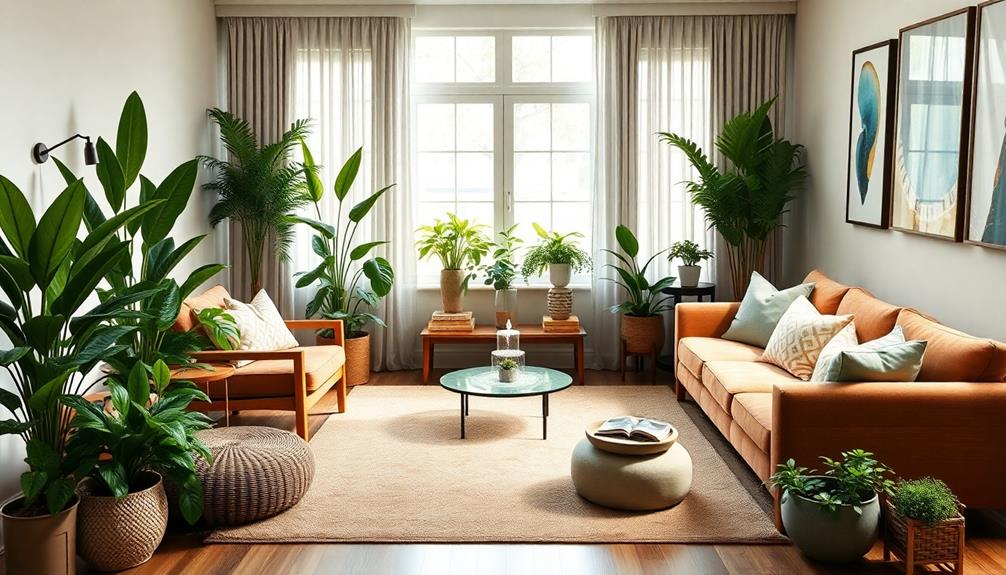
When it comes to enhancing the energy in your home, each room has unique characteristics that can be optimized with specific Feng Shui tips.
In the living room, arrange your furniture to facilitate face-to-face interactions and maximize natural light. This creates a welcoming atmosphere that encourages social connections and positive energy flow.
In the bedroom, position your bed for a commanding view of the entrance, keeping the space clutter-free. Using natural fabrics and earthy colors promotes relaxation and restful sleep, essential for creating a balanced environment.
For your home office, place your desk so you can see the entrance, which minimizes distractions and enhances productivity. An organized workspace allows positive energy to circulate, boosting your focus.
Lastly, in the bathroom, create a clean and inviting atmosphere. Mindful mirror placement and incorporating natural materials ground energy, fostering a sense of tranquility.
Personalizing Your Feng Shui Space

Optimizing your Feng Shui space goes beyond room-specific tips; it's about making your environment truly yours. Personalizing your Feng Shui space involves selecting colors, materials, and decor that resonate with your unique personality. By incorporating feng shui color tips for homes, you can create a harmonious atmosphere tailored to your preferences and energy. Choose shades that evoke positivity and balance, such as soothing blues for relaxation or vibrant reds for passion and vitality. Don’t be afraid to mix textures and elements, ensuring your space feels both uplifting and authentically yours.
Start by using earthy colors and natural materials to create a nurturing atmosphere, reinforcing the Earth element's grounding energy in your home.
Utilize the Bagua Map to identify areas of your life you'd like to enhance, such as wealth or relationships. Incorporate elements that symbolize your goals, like a water feature for abundance or family photos for connection.
Adding personal items, like meaningful artifacts or travel souvenirs, fosters a deeper emotional connection to your space, enhancing your well-being.
Regularly reassess your environment to align with your evolving needs and aspirations. Changing decor or rearranging furniture can rejuvenate your energy flow, ensuring your Feng Shui remains dynamic and supportive.
Frequently Asked Questions
Can Feng Shui Improve My Sleep Quality?
Yes, incorporating Feng Shui can improve your sleep quality. By arranging your bedroom to promote harmony and balance, you'll create a peaceful environment that encourages relaxation, helping you fall asleep faster and enjoy deeper rest.
How Often Should I Refresh My Feng Shui Arrangements?
You should refresh your feng shui arrangements regularly, ideally every season or when energy feels stagnant. Moving furniture, changing decor, or introducing new elements can keep your space vibrant, balanced, and aligned with your intentions.
Is Feng Shui Effective in Small Apartments?
Yes, feng shui's effective in small apartments! You can create harmony and balance by arranging furniture, colors, and decor thoughtfully. Even limited space can reflect positive energy when you apply feng shui principles.
Can I Use Feng Shui for Outdoor Spaces?
You might think feng shui only applies indoors, but you can absolutely use it outdoors! By arranging plants, pathways, and furniture mindfully, you'll create harmony, inviting positive energy into your outdoor spaces.
Are There Specific Colors That Enhance Feng Shui?
Yes, specific colors can enhance feng shui. For instance, greens promote growth, blues encourage calm, and reds energize. You should choose colors that resonate with your intentions for balance and harmony in your space.
Conclusion
By embracing the art of feng shui, you're not just rearranging furniture; you're weaving a tapestry of harmony within your home. Like sunlight streaming through a window, the right energy will illuminate your space, inviting peace and balance. As you apply these principles, you'll transform your environment into a sanctuary that nurtures your spirit and fuels your passions. So go ahead, release that hidden power, and watch your interior flourish like a garden in full bloom!
Home Decor & Design
The Surprising Feng Shui Mistake That’s Ruining Your Home’s Energy
Banish chaos from your entryway to boost your home’s energy; discover the surprising mistake that could be holding you back.
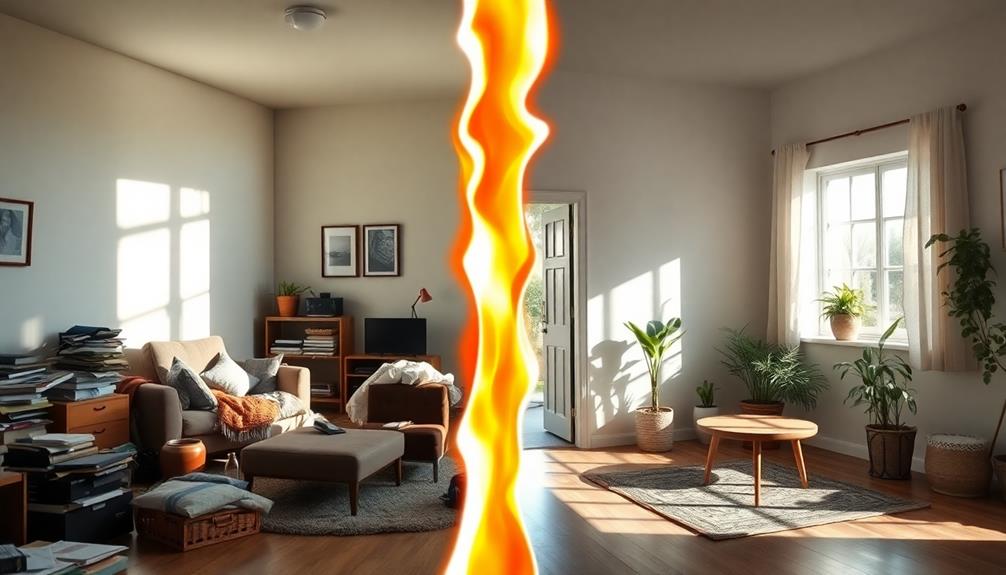
The surprising feng shui mistake ruining your home's energy is a cluttered entryway. This area serves as the first impression and can block the flow of positive energy. If it's messy or uninviting, you may feel stress and overwhelm as soon as you walk in. To enhance your home's vibe, keep the entryway tidy and welcoming. Clear out unnecessary items regularly to promote tranquility. Also, consider how electronics are positioned, as they can disrupt your space's harmony. By addressing these areas, you can greatly uplift your home's energy. There's much more to explore in creating a balanced living space.
Key Takeaways
- Cluttered entryways block positive energy flow, making first impressions uninviting and stressful.
- Disorganized spaces create psychological stress, hindering relaxation and productivity in your home.
- Electronics in bedrooms disrupt sleep quality and intimacy, negatively impacting overall well-being.
- Under-bed clutter prevents restful sleep and can lead to feelings of vulnerability.
- Neglecting the central area of your home results in stagnant energy and disorganization, affecting overall harmony.
The Importance of Entryways
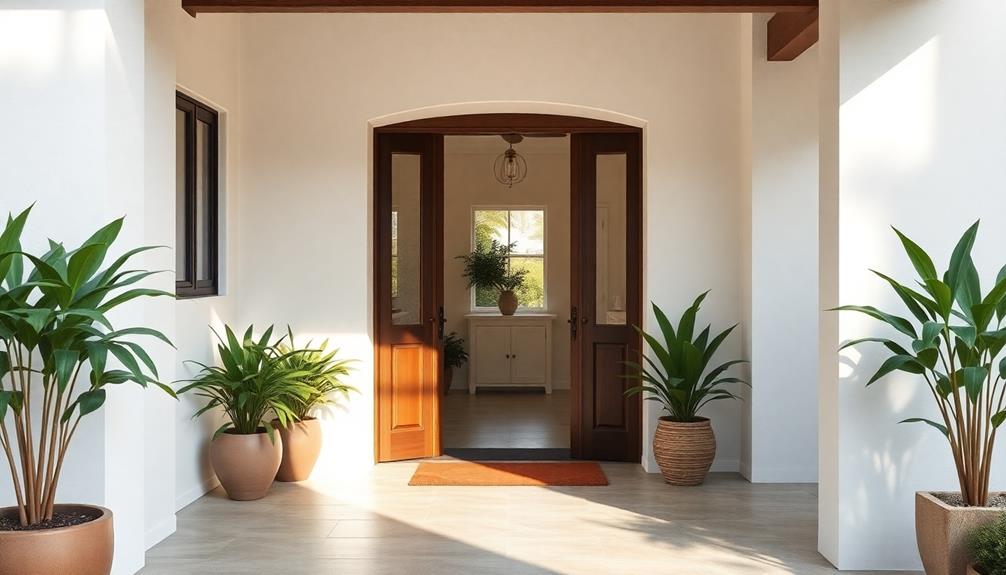
The entryway is more than just a passage; it's the first impression your home makes and an essential space for welcoming positive energy. A well-designed entryway sets the tone for your entire home, influencing the energy that flows throughout.
Incorporating elements of traditional artistry through vibrant Indonesian decor masks can enhance the visual appeal and cultural depth of your entryway. If your entryway is cluttered or uninviting, you might inadvertently block good energy from entering your space.
To enhance your entryway, focus on creating an aesthetically pleasing and organized environment. Consider adding new furniture or drapery that complements your style while also promoting a sense of warmth and welcome. A clean and decorated entryway encourages positive energy and makes guests feel at home.
Make sure to use the front door as your primary entry point. Entering through the back door or garage can disrupt the energy flow and create a disconnection with your space.
Ideally, you should have a welcoming corner that's visible immediately upon entering. This little touch can greatly influence the atmosphere, fostering a sense of tranquility and positivity.
Bedroom Layout Considerations
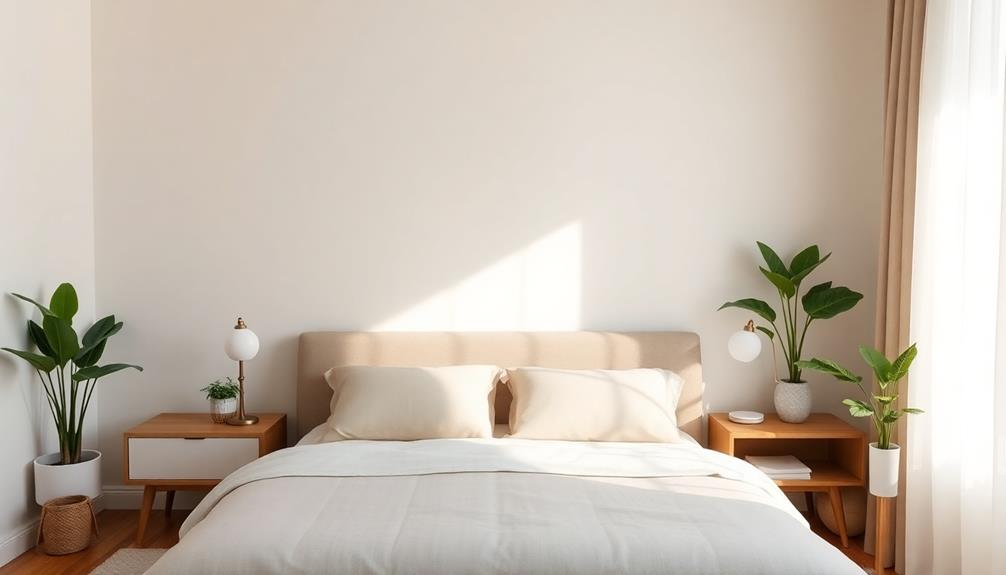
Creating a harmonious atmosphere in your home extends beyond the entryway; it flows into the bedroom, where layout plays an essential role in promoting relaxation and well-being. To achieve this, make sure your bed is positioned furthest from the door while still being visible. This arrangement fosters a sense of security and comfort, vital for restful sleep.
Incorporating natural materials and soothing earth tones, as seen in Balinese design characteristics, can further enhance the tranquility of your space.
Avoid placing the bed directly in line with the door, as this can create feelings of vulnerability, disrupting your ability to unwind. Additionally, be cautious of tall furniture next to the bed; it can block your view and lead to unease, negatively impacting your sleep quality.
You'll also want to keep the area beneath your bed clear. Storing items there can create clutter, disrupting the energy flow and making it harder to relax.
Finally, think about electronics. Keeping devices like TVs out of the bedroom helps reduce distractions and promotes better energy alignment, enhancing your personal relationships.
Clutter and Energy Flow
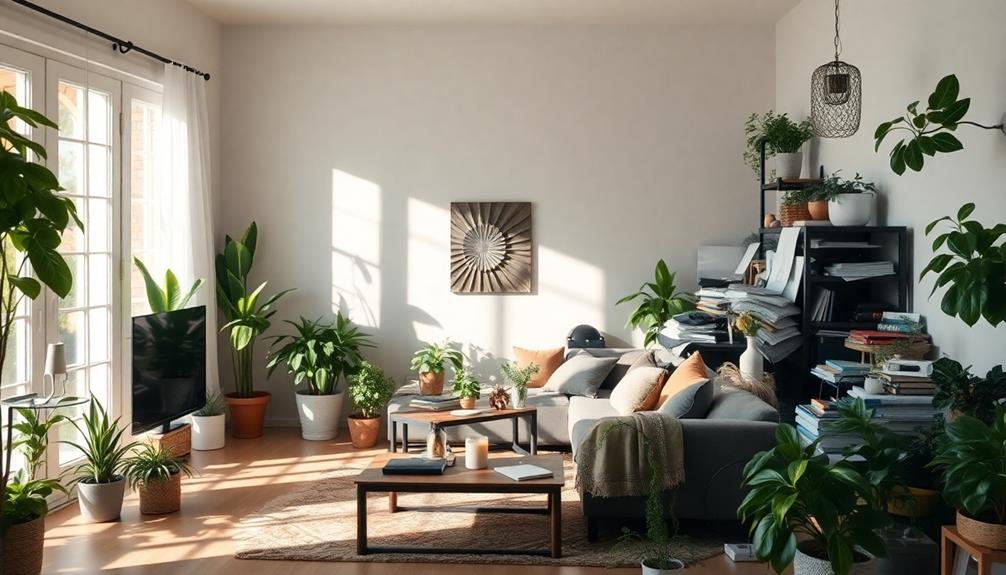
Clutter can seriously disrupt the energy flow in your home, leaving you feeling stressed and unproductive.
Incorporating elements like Indonesian decorative pillows can add vibrancy and comfort to your space, enhancing the overall vibe.
By regularly evaluating your space and removing unnecessary items, you can enhance the overall vibe and create a more harmonious environment.
Mindful management of your belongings, like using smaller trash cans, helps prevent clutter and promotes a positive energy space.
Impact of Clutter
A chaotic environment can greatly disrupt the energy flow in your home, affecting your overall well-being and productivity. The impact of clutter can make you feel overwhelmed, stressed, and unfocused.
When your surroundings are disorganized, it becomes challenging to relax or concentrate, especially in spaces meant for rest, like your bedroom. Incorporating elements like an Indonesian decor mask can enhance your decor while embracing cultural richness, contributing to a more harmonious environment.
Consider how clutter can:
- Create psychological stress that weighs you down.
- Block positive energy from entering your space.
- Make it harder to find what you need, increasing frustration.
- Diminish your ability to enjoy peaceful moments.
- Lead to missed opportunities in relationships and personal growth.
Regularly evaluating and removing unnecessary items can greatly enhance the vibe of your living spaces. Keeping smaller trash cans around can also encourage mindful waste management, further reducing visible clutter.
In feng shui, maintaining a clear and organized environment isn't just about aesthetics—it's essential for attracting positive energy and fostering better relationships and opportunities. By addressing the impact of clutter, you can transform your home into a sanctuary that promotes harmony and well-being.
Enhancing Energy Flow
When you declutter your space, you pave the way for energy to flow freely and positively throughout your home. Clutter disrupts this flow, leading to feelings of overwhelm and stress, which is a huge mistake if you're aiming to enhance energy flow. Regularly evaluating each room allows positive energy to circulate, creating a harmonious environment.
| Room | Clutter Impact | Action to Take |
|---|---|---|
| Bedroom | Hinders attraction of love | Minimize electronics |
| Living Room | Creates chaos | Remove unnecessary items |
| Kitchen | Blocks productivity | Organize and simplify |
| Home Office | Increases stress | Keep only essentials |
| Center of the Room | Detracts from health and self | Add vibrant decor |
Maintaining smaller trash cans encourages mindful waste management, reducing visible clutter and enhancing your space's overall vibe. Remember, a vibrant center symbolizes health, so incorporate elements that promote energy balance. By taking these steps, you'll not only declutter but also invite a revitalizing flow of energy into your home, making it a sanctuary for well-being.
Mindful Space Management
Maintaining a harmonious energy flow goes hand in hand with mindful space management. When your space is cluttered, it disrupts the energy flow in your home, leading to decreased productivity and heightened stress.
To restore balance and enhance your well-being, consider these tips:
- Assess regularly: Make it a habit to declutter spaces and remove items that no longer serve a purpose, just as one might incorporate traditional elements for cultural significance in event decor like Indonesian wedding decor ideas.
- Clear under the bed: This area should remain unobstructed to promote restful sleep and a sense of peace.
- Manage visible clutter: Use smaller trash cans to encourage mindful waste management and limit unnecessary accumulation.
- Limit electronics in the bedroom: Keeping TVs and other distractions out fosters a serene atmosphere essential for love and relaxation.
- Enhance decorative elements: Carefully incorporate decor to maintain a vibrant center in your living spaces, symbolizing health and liveliness in feng shui interior design.
Managing Electronics in Spaces
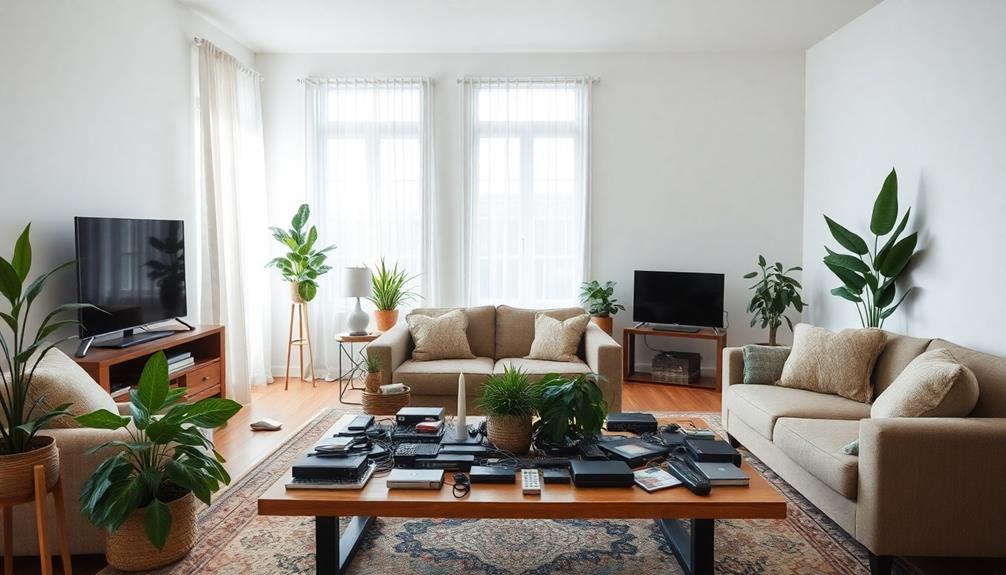
When it comes to managing electronics in your home, think carefully about their placement, especially in the bedroom.
Keeping devices like TVs there can disrupt the serene energy needed for restful relationships.
Bedroom Electronics Considerations
In today's fast-paced world, managing electronics in your bedroom is essential for fostering a peaceful and loving atmosphere.
Bedroom electronics can disrupt sleep quality and create a less romantic vibe, impacting your relationships. To cultivate a serene space filled with beautiful things, consider these tips:
- Remove the TV: If possible, relocate it to a living room to enhance your bedroom's energy.
- Cover when not in use: If you must keep a television, drape it with a cloth to minimize its negative effects.
- Limit gadgets: Keep only essential electronics, opting for alarm clocks over phones to avoid distractions.
- Create zones: Designate specific areas in the bedroom for relaxation, free from electronic interference.
- Regularly assess: Evaluate your electronics' placement and consider moving them to maintain a tranquil environment.
Clutter-Free Living Spaces
To create a clutter-free living space, it is crucial to regularly evaluate the electronics you have on display. Clutter disrupts energy flow, so minimizing visible items can enhance your environment's harmony. Consider relocating TVs from bedrooms to living areas. This not only promotes better energy but also encourages healthier relationships. If you must keep a TV in the bedroom, cover it with a cloth to lessen its impact.
Here's how you can manage your electronics effectively:
| Electronics | Action to Reduce Clutter |
|---|---|
| TV | Relocate to living area |
| Gaming Consoles | Store in entertainment center |
| Chargers & Cables | Use a cable organizer |
| Laptops/Computers | Designate a work area |
| Small Devices (e.g., tablets) | Limit display, store when not in use |
Incorporating smaller trash cans encourages mindful waste management, which contributes to a serene and organized space. By taking these steps, you'll not only reduce visible clutter but also create a more positive living experience, enhancing the overall energy of your home.
Enhancing Window Treatments
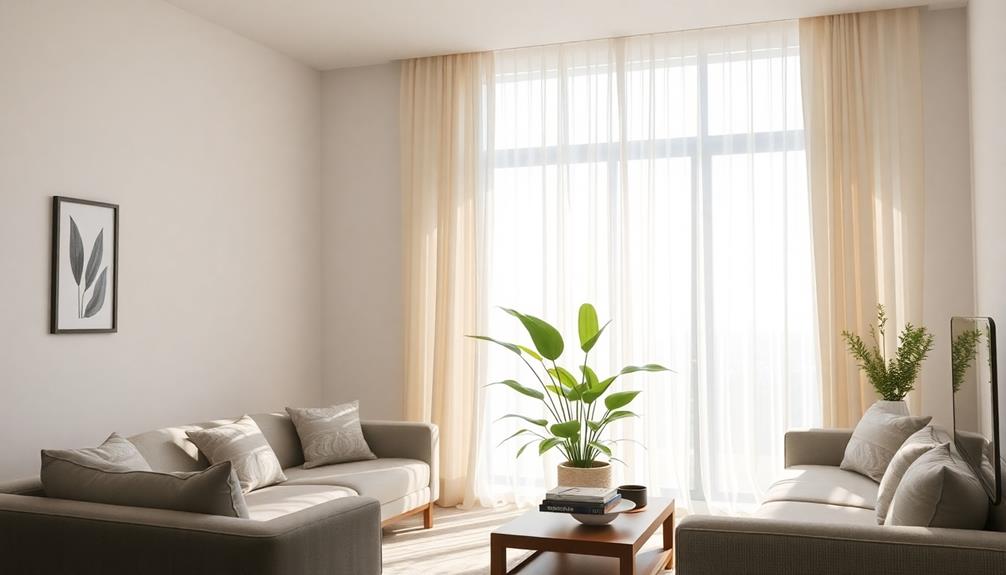
Window treatments play an important role in creating a harmonious environment in your home. Uncovered windows can expose vulnerability and disrupt the energy flow in a room, so it's vital to prioritize effective window coverings.
Here are some ideas to enhance your window treatments:
- Drapery: Adds softness and provides protection, improving the overall aesthetic and energy of your space.
- Blinds: Allow you to regulate natural light, influencing the room's mood and energy throughout the day.
- Sheer curtains: Offer privacy while still letting in natural light, creating a calming atmosphere.
- Roman shades: Provide a stylish option that can complement your decor while keeping energy flow intact.
- Feng Shui designs: Choosing coverings that align with feng shui principles can greatly improve harmony and positive energy in your home.
Seeking Professional Feng Shui Help

Enhancing your window treatments can set the stage for a balanced and inviting home, but sometimes, expert advice is necessary to achieve the best energy flow. Seeking professional feng shui help can be a great solution to guarantee your home resonates with positive energy.
A feng shui expert can provide tailored guidance that aligns with your unique space, helping you understand the significance of your home's direction and how personal elements contribute to a harmonious environment.
Online consultations with feng shui professionals offer flexibility, allowing you to receive guidance from the comfort of your own home. With their expertise, you can uncover hidden mistakes in your decor that might be disrupting the energy flow. This insight can lead to significant improvements in your overall well-being.
Moreover, feng shui experts can recommend specific decorative elements, like rugs or coffee tables, that enhance the energy in key areas of your space. By incorporating these suggestions, you'll not only elevate the aesthetics of your home but also foster a thriving atmosphere that promotes health and self-awareness.
Don't underestimate the power of professional advice—it could be the transformative step your home needs.
The Role of Decorative Elements
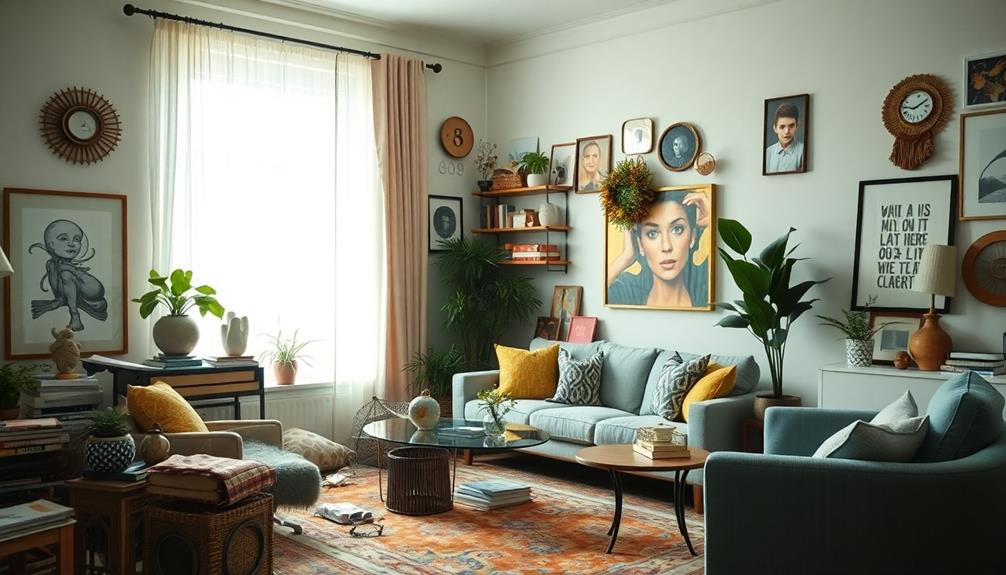
Incorporating decorative elements like rugs and coffee tables plays an essential role in creating a harmonious and inviting home. When you strategically place these items, they symbolize self and health, enhancing the overall energy flow of the space.
By aligning your decorative elements with feng shui principles, you promote a balanced atmosphere that fosters well-being.
Consider the following tips to optimize your decorative choices:
- Use vibrant colors: Bright hues can invigorate the vibe of a room.
- Choose functional pieces: Guarantee your decor serves a purpose beyond aesthetics.
- Create focal points: Position key items to draw the eye and enhance energy flow.
- Regularly update decor: Refresh your space to remove clutter and stagnant energy.
- Incorporate natural elements: Plants and organic materials can enhance emotional comfort.
Maintaining a Balanced Center
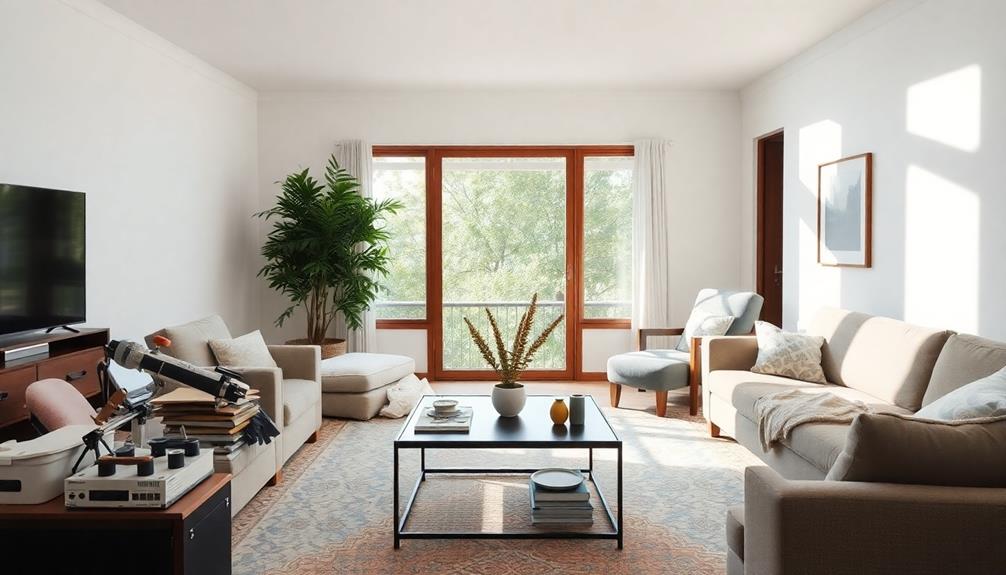
A well-maintained center in your home is fundamental for promoting health and well-being. This central area symbolizes your energy, so keeping it vibrant and clutter-free is imperative for fostering positive energy flow.
Regularly assess this space for any disorganization or unnecessary items. Clutter can disrupt energy movement, affecting your overall health.
To maintain a balanced center, consider how you arrange your furniture and decor. Aligning these elements according to feng shui principles creates harmony and stability.
Decorative items like rugs or coffee tables can enhance energy, contributing to a more inviting atmosphere.
Incorporating plants or natural elements is another fantastic way to invigorate the center of your home. These additions promote a sense of life and health, further boosting the positive energy around you.
Choose greenery that thrives indoors, as it not only beautifies the space but also purifies the air.
Frequently Asked Questions
How Do You Get Rid of Bad Energy in Feng Shui?
To get rid of bad energy in feng shui, declutter your space, use soft window treatments for privacy, position your bed away from the door, and remove electronics from the bedroom for a serene atmosphere.
What Is Considered Bad Feng Shui for a House?
Bad feng shui for your house includes cluttered spaces, a bed aligned with the door, and electronics in the bedroom. These factors disrupt energy flow, create discomfort, and hinder relationships, affecting your overall well-being.
What Are the Symptoms of Bad Feng Shui?
You might notice symptoms of bad feng shui like clutter causing stress, a poorly positioned bed leading to poor sleep, or an unwelcoming entryway creating negative energy. These issues disrupt your home's overall harmony and comfort.
What Destroys the Earth in Feng Shui?
Disorganized distractions destroy the earth energy in feng shui. You've gotta clear clutter, avoid sharp angles, and guarantee balanced elements. By maintaining harmony, you'll nurture a nurturing environment that fosters stability and serenity in your space.
Conclusion
In the dance of energy within your home, every element plays an essential role. By addressing entryways, managing clutter, and harmonizing your spaces, you can invite a rejuvenating breeze of positivity. Don't let those sneaky feng shui mistakes weigh down your vibe—lighten your load and let your home sing with balance and joy. With a sprinkle of care and perhaps a dash of professional insight, you'll create a sanctuary that resonates with vibrant energy. Embracing feng shui for chaotic homes can be the first step toward transforming disorder into harmony. By thoughtfully arranging furniture, incorporating natural elements, and ensuring ample light, you create a flow that supports both peace and productivity. This mindful approach not only nurtures the energy of your home but also enriches the spirit of everyone within it.
Home Decor & Design
Why Feng Shui Should Be Your Next Design Move for a Harmonious Home
Transform your home with Feng Shui principles for enhanced harmony; discover how small adjustments can lead to significant changes in your space.
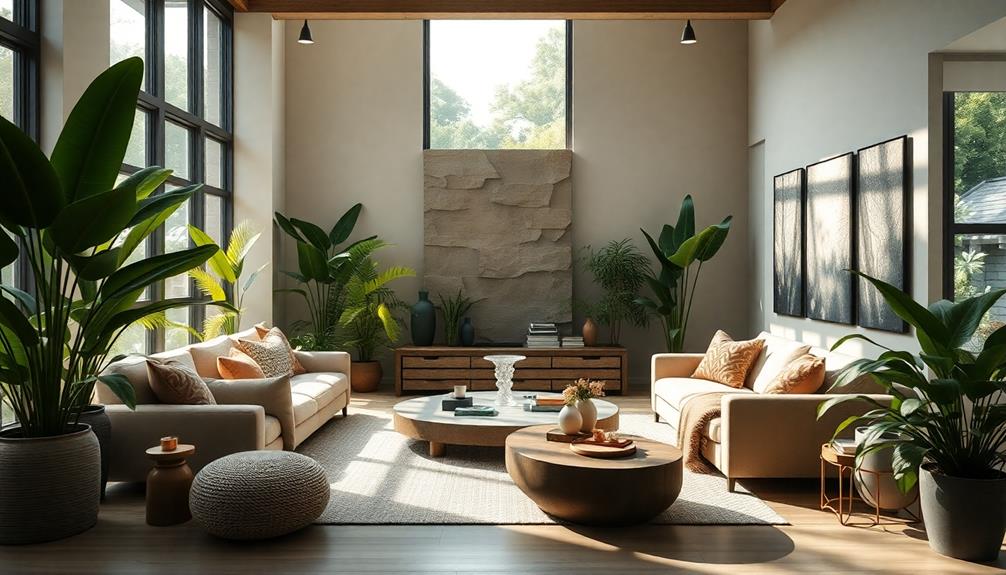
If you want a harmonious home, embracing Feng Shui is a game changer. It enhances the flow of positive energy, or chi, creating a tranquil atmosphere. By incorporating natural elements and balancing the five elements of nature, your space becomes a haven for relaxation and well-being. Strategic room arrangements boost comfort and connection, while decluttering clears your mind. Using the Bagua Map helps you align your environment with your personal goals, promoting prosperity in key life areas. You'll discover that even small adjustments can create big impacts, and there's so much more you can explore to achieve balance and harmony.
Key Takeaways
- Feng Shui enhances positive energy flow, creating a harmonious atmosphere that improves overall well-being and comfort in your home.
- Incorporating the Five Elements fosters balance, ensuring that your space supports various aspects of life, like health and prosperity.
- Mindful decluttering and space management boost mental clarity, allowing for a more peaceful and rejuvenating environment.
- Strategic room arrangement and natural elements connect you to nature, promoting tranquility and enhancing your living experience.
- Engaging with Feng Shui principles encourages mindfulness and intentionality, leading to a more fulfilling and harmonious lifestyle.
Understanding Feng Shui Principles

What makes Feng Shui such a vital practice for creating a harmonious home? At its core, Feng Shui focuses on the flow of energy, or chi, in your space. By understanding its principles, you can enhance this energy flow and cultivate a balanced environment.
One of the key tools is the Bagua Map, which helps you identify areas of your life—like wealth and health—within your home. Incorporating elements like Indonesian decorative pillows can add vibrant colors and intricate patterns that not only enhance the aesthetics but also promote a sense of comfort and cultural heritage.
Incorporating the Five Elements—wood, fire, earth, metal, and water—into your decor allows you to create a dynamic equilibrium. Achieving balance between Yin and Yang is important; the calm, soft energies should complement the active, bright ones.
Decluttering plays a significant role in this practice, as it clears away stagnant energy, promoting mental clarity and improving the overall flow of positive energy throughout your home.
Additionally, integrating natural elements can enhance your space, supporting both good health and a sense of peace. By applying these principles, you're not just creating a beautiful space; you're fostering a truly harmonious home that nourishes your well-being.
Choosing a Harmonious Home
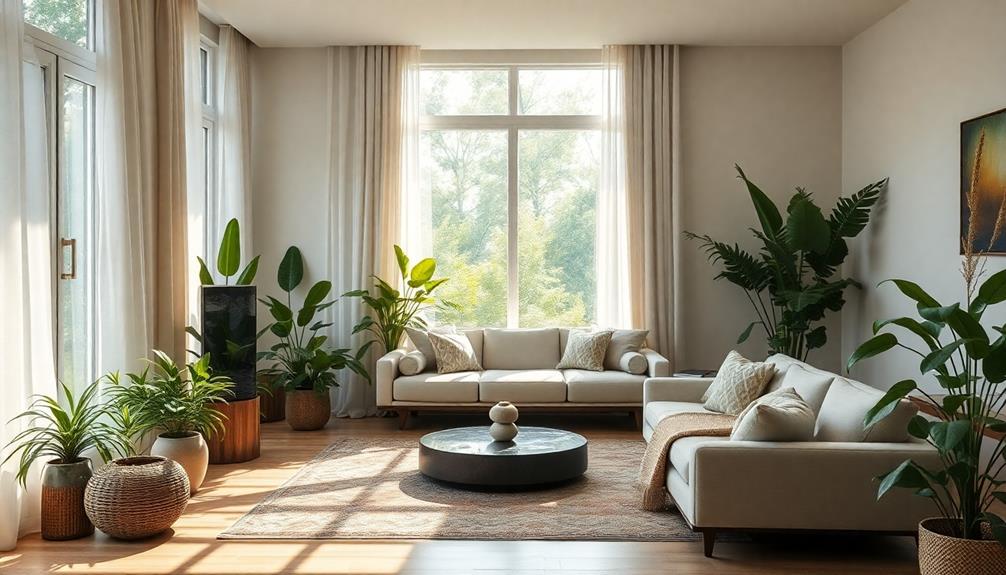
Choosing a harmonious home involves careful consideration of various factors that influence the flow of energy within your living space. When it comes to Feng Shui, a well-designed floor plan is essential for promoting positive chi circulation.
You'll want to prioritize deeper floor plans, as they typically support better energy flow compared to wider structures, fostering an environment conducive to harmonious living. Incorporating unique decor elements, such as a Face Indonesian Decor Mask, can enhance the aesthetic appeal while reflecting cultural heritage.
Pay attention to key features like ceiling height and bathroom placement; these can greatly impact the energy of your space. Comfortable ceiling heights and thoughtfully located bathrooms enhance your overall well-being.
Engaging with Feng Shui experts during your home selection process can offer invaluable insights into how a potential home's design aligns with natural energy flow and meets your personal needs.
Utilizing the Bagua Map can be particularly helpful in evaluating a home. It allows you to identify areas of focus for prosperity, relationships, and overall harmony.
Key Areas for Feng Shui
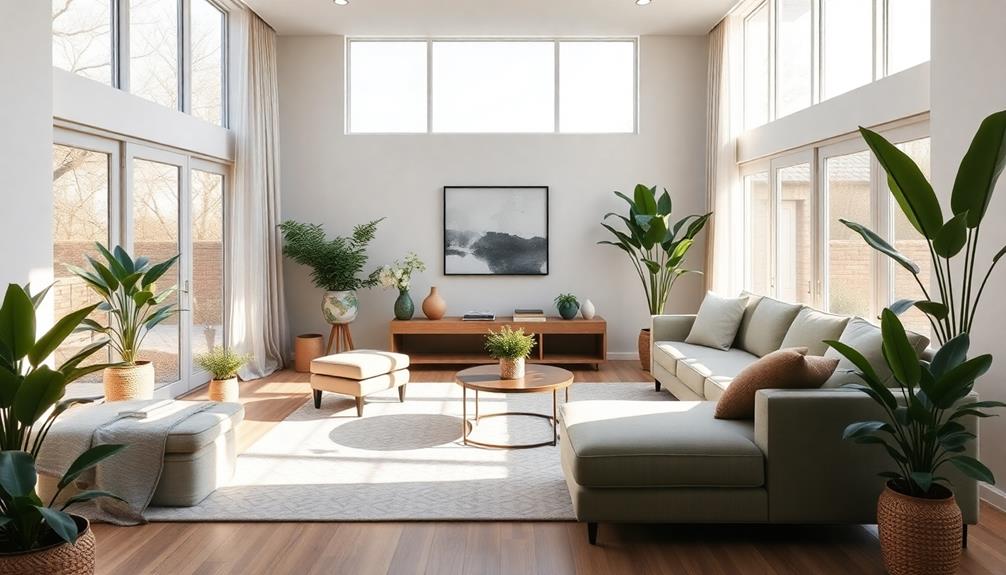
When you think about key areas for Feng Shui, consider how energy flows through your home and the layout of your spaces.
By creating open pathways and thoughtful arrangements, you can enhance the positive energy in each room. Incorporating elements of Balinese design characteristics can further amplify this energy by promoting a connection to nature and using natural materials.
Let's explore some practical strategies to optimize your home's energy flow.
Energy Flow Principles
To create a harmonious home, understanding the energy flow principles of feng shui is crucial. The concept of Chi, or energy flow, is central to feng shui, emphasizing how a well-designed space can enhance your overall well-being.
Incorporating natural materials like wood and bamboo, as seen in traditional Indonesian style home decor, can further enhance the energy flow in your living spaces. Start by ensuring your main doors are clear and clutter-free. This simple step allows for ideal energy circulation, promoting good energy, health, and prosperity.
Utilizing the Bagua Map is essential in identifying which areas of your space correspond to specific life aspects. This tool helps you target enhancements that improve energy flow and align with your personal goals.
Space Layout Strategies
Effective space layout strategies are vital for optimizing feng shui in your home. You should prioritize a deeper floor plan over a wider structure to encourage positive energy flow throughout your living space.
When considering furniture placement, make sure that pathways remain unobstructed, allowing chi to circulate freely without blockages. This is significant for maintaining a clutter-free environment, especially in entryways, as they symbolize the flow of opportunities and energy entering your home.
Additionally, drawing inspiration from cultural elements, such as Indonesian wedding decor ideas, can enhance the aesthetic and energy of your space, promoting a harmonious atmosphere.
Also, pay attention to your room layout and ceiling heights; high ceilings can create a sense of openness in larger rooms, while lower ceilings foster coziness in smaller spaces.
In the bedroom, consider diagonal bed placement, which enhances energy flow and promotes a sense of security and relaxation, aligning with traditional Chinese philosophy.
Decorating for Balance

Creating a balanced environment in your home can greatly enhance your overall well-being. To achieve this, focus on incorporating Feng Shui principles that promote harmony and positive energy. Start by bringing in natural elements like plants and water features, which enhance energy flow and foster a sense of calm.
Utilizing mirrors strategically can also amplify light and positive energy, but be mindful of their placement to avoid disrupting the flow of chi. Aim for symmetry in your decor; matching nightstands in bedrooms can create stability and balance in your spaces.
Adjusting your color palette plays a vital role as well. Calming colors like blues and greens promote tranquility, while limiting excessive reds can help reduce anxiety. Finally, regular decluttering is essential for maintaining balance; removing items that no longer serve you can greatly improve energy flow.
Here's a quick reference table to help you create balance in your home:
| Element | Purpose |
|---|---|
| Natural Elements | Enhance energy flow |
| Symmetry | Create stability and harmony |
| Color Palette | Influence mood and tranquility |
Mindful Space Management

Maintaining balance in your home sets the stage for mindful space management, which focuses on how you can optimize your environment for well-being. In Feng Shui, decluttering is essential as it promotes mental clarity and allows positive energy, or chi, to flow freely throughout your space.
By regularly evaluating what you keep, you can rejuvenate your home and create a serene atmosphere.
Small, intentional changes can also transform your environment. Rearranging furniture or incorporating natural elements like wood, water, and plants can create a balanced environment that supports emotional well-being.
These elements help foster a deeper connection to nature and enhance the overall vibe of your personal space.
Reflect on the items in your home. If something no longer serves a purpose, consider letting it go. This practice not only clears physical space but also cultivates a harmonious home.
By adopting mindful space management techniques, you create a supportive setting that nurtures your spirit and invites positive energy into your life.
Embrace these principles, and watch how your living space evolves into a more vibrant and inviting sanctuary.
Simple Practices for Harmony
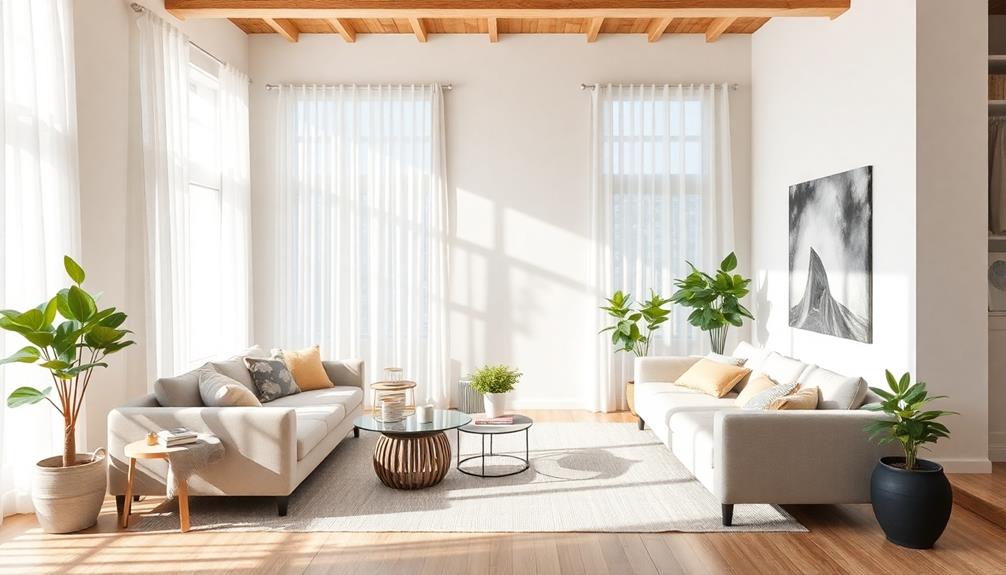
Achieving harmony in your home doesn't have to be complicated; simple practices can make a significant difference. Start by decluttering your space—consider releasing nine items over nine days. This mindful adjustment creates a positive energy shift that promotes balance.
Next, rearranging furniture can enhance the flow of energy. Make sure your seating allows for conversation and connection, improving comfort and chi.
Incorporate natural elements, like plants or wooden materials, to strengthen your connection to nature. These additions not only beautify your space but also foster a calming atmosphere.
Use calming colors—soft earth tones, for example—to create a tranquil environment conducive to relaxation.
Don't forget the importance of fresh air and natural light. Regularly open your windows to invite in these elements, enhancing the energy flow while boosting both physical health and emotional well-being.
Frequently Asked Questions
What Is the Best Feng Shui Orientation for a House?
The best feng shui orientation for your house is south-facing, as it attracts positive energy and sunlight. If you can, consider east for morning light, or north for a calming environment, ensuring unobstructed surroundings.
How to Arrange Your Home According to Feng Shui?
For a fabulous feng shui setup, start by strategically situating your bed, clearing cluttered corners, balancing the five elements, and embracing your entryway. These steps invite invigorating energy, promoting peace and positivity throughout your home.
What Is Bad Feng Shui for a House?
Bad feng shui for your house includes blocked entryways, cluttered spaces, and poor bed placement. Excessive red decor can increase stress, while dark rooms may leave you feeling uneasy and drained. Keep your spaces balanced and welcoming.
When Should I Move My House Feng Shui?
If you're feeling stuck after a major life change, like starting a new job, it's time to contemplate moving. Feng Shui suggests that a fresh space can help restore balance and promote positive energy flow.
Conclusion
Embracing feng shui isn't just about aesthetics; it's about creating a sanctuary that nurtures your spirit. By integrating these principles into your design choices, you're inviting balance and harmony into your life. Just think—what if your home could be a reflection of peace and positivity? With thoughtful arrangements and mindful practices, you can transform your space into a haven that rejuvenates your mind and soul. So, why not take that step toward a more harmonious home today? Start by exploring simple feng shui tips for homeowners, such as decluttering to allow energy to flow freely and incorporating natural elements like plants or water features to foster a sense of tranquility. Small changes, like adjusting furniture placement to encourage movement or bringing in calming colors, can make a big difference. Remember, each tweak you make brings you closer to a space that not only looks beautiful but also feels deeply restorative.
-

 id6 months ago
id6 months agoPanduan Karir Internasional untuk Warga Indonesia
-

 id6 months ago
id6 months agoTemukan Keindahan Pendopo Jakarta sebagai Destinasi Anda
-

 id6 months ago
id6 months agoBerbagi Opini Anda – Wawasan untuk Indonesia
-

 News6 months ago
News6 months agoUnderstanding Ekonomi: Basics and Beyond
-

 id6 months ago
id6 months agoBerita-Terkini Indonesia: Info Terbaru Hari Ini
-

 id6 months ago
id6 months agoKesra Sebagai Pilihan Pangan Sehat untuk Keluarga
-

 id6 months ago
id6 months agoRahasia Sehat dengan Olahraga Rutin Anda
-

 News5 months ago
News5 months agoThe Heartbreaking Story of Tim Chapman's Wife

























